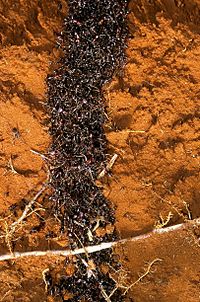Army ant

Army ant (or legionary ant or "Marabunta") means over 200 ant species. They are called army ants due to their aggressive predatory groups looking for food, known as "raids", in which many ants look for food at the same time in one place, attacking other animals collectively.
Army ants do not build a nest like most other ants. Instead, they build a living, temporary nest with their bodies. All army ant species are part of the ant family, Formicidae. There are several kinds that have evolved on their own the same behavior. This is called "legionary behavior", and is convergent evolution.[1]
Usage[change | change source]
Before, "army ant" meant ants from 5 different ant subfamilies: in two of these subfamilies, the Ponerinae and Myrmicinae, it is only a few species that show legionary behavior; in the other three subfamilies, Ecitoninae, Dorylinae, and Leptanillinae, all of the species are legionary. Now, another subfamily Leptanilloidinae, is called army ants.
A 2003 study of thirty species (by Sean Brady of Cornell University) shows that the ecitonine and doryline army ants evolved from one group in the mid-Cretaceous period in Gondwana,[2] and so the two subfamilies are now one called Ecitoninae, but not everyone says this.[3]
These are army ants:
- Subfamily Ponerinae
- Leptogenys (some species)
- Onychomyrmex
- Simopelta
- Subfamily Myrmicinae
- Subfamily Leptanilloidinae
- Subfamily Leptanillinae
- Subfamily Ecitoninae
Related pages[change | change source]
References[change | change source]
- ↑ Dawkins, Richard (2000) [1986]. "4. Making tracks through animal space". The blind watchmaker. Penguin books. p. 132. ISBN 0-140-29122-9.
[evolutionary] convergences [...] wandering in enormous pillaging armies. This is called the legionary habit.
- ↑ Whitehouse, David (2003-05-10). "Ant history revealed". BBC News. Retrieved 2009-01-14.
scientists postulated that they evolved many times after the break-up and dispersal of the supercontinent Gondwana just over 100 million years ago. The conventional view of the evolution of army ants needs a revision because of new data obtained by Sean Brady, a Cornell University, US, entomologist who has discovered that these ants evolved from a common ancestor.
BBC News, Dr. David Whitehouse, "Ant history revealed" 10 May 2003. - ↑ Engel, Michael S.; David A. Grimaldi (2005). "Primitive new ants in Cretaceous amber from Myanmar, New Jersey, and Canada (Hymenoptera: Formicidae)". American Museum Novitates (3485). New York, NY: American Museum of Natural History: 1–24. doi:10.1206/0003-0082(2005)485[0001:PNAICA]2.0.CO;2. hdl:2246/5676. S2CID 84043939. Retrieved 2009-01-14.
Further reading[change | change source]
- Brady, S. (2003). "Evolution of the army ant syndrome: the origin and long-term evolutionary stasis of a complex of behavioral and reproductive adaptations". Proceedings of the National Academy of Sciences of the United States of America. 100 (11): 6575–6579. doi:10.1073/pnas.1137809100. PMC 164488. PMID 12750466. PNAS 100(11): 6575-6579.
- Gotwald, W.H., Jr. (1995). Army ants: the biology of social predation. Ithaca, New York: Cornell University Press. ISBN 0-8014-9932-1.
{{cite book}}: CS1 maint: multiple names: authors list (link) - Rice, Nathan H., and A. M. Hutson (2003). "Antbirds and Army-Ant Swarms". In Christopher Perrins (Ed.) (ed.). Firefly Encyclopedia of Birds. Firefly Books. p. 449. ISBN 1-55297-777-3.
{{cite book}}: CS1 maint: multiple names: authors list (link) - Wilson, Edward O, and Bert Hölldobler, (1990) The Ants (Pulitzer Prize)
Other websites[change | change source]
- A Comprehensive Ant Website
- Army Ants Plug Potholes Archived 2010-06-29 at the Wayback Machine, March 2009.
- Army ant research page: personal website on research and computer modeling of army ants
- Instinct to swarm
